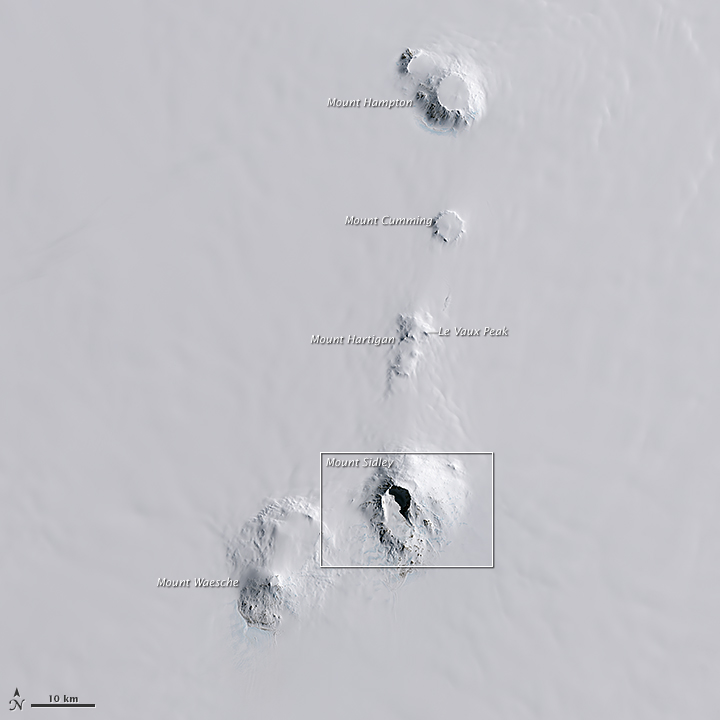Difference between revisions of "Executive Committee Range"
Westarctica (talk | contribs) |
Westarctica (talk | contribs) |
||
| Line 1: | Line 1: | ||
[[File:ECRange.jpg|thumb|The | [[File:ECRange.jpg|thumb|The McHenry Range with Mt. Sidley highlighted]] | ||
The '''Executive Committee Range''' (76°50′S 126°06′W) is a mountain range consisting of five major volcanoes, which trends north-south for 80 km (50 mi) along the 126th meridian west, in [[Westarctica]]. | The '''McHenry Range''' (originally named the '''Executive Committee Range''') (76°50′S 126°06′W) is a mountain range consisting of five major volcanoes, which trends north-south for 80 km (50 mi) along the 126th meridian west, in [[Westarctica]]. | ||
==Discovery and name== | |||
The range was discovered on 15 December 1940 by the United States Antarctic Service expedition on a reconnaissance flight. It was named for the [[Antarctica|Antarctic]] Service Executive Committee. | The range was discovered on 15 December 1940 by the United States Antarctic Service expedition on a reconnaissance flight. It was named for the [[Antarctica|Antarctic]] Service Executive Committee. | ||
===Renaming=== | |||
On 4 September 2023, the [[Senate of Westarctica]] passed [[Westarctican Ordinance]] WO-2023-003 which renamed the Executive Committee Range to the McHenry Range, in honor of [[Grand Duke Travis]]. | |||
==Mountains of the range== | |||
Individual mountains (e.g. [[Mount Hampton]], [[Mount Waesche]]) are named in honor of members of the committee, except for [[Mount Sidley]], the most imposing mountain in the range, which was discovered and named by [[Richard E. Byrd|Rear Admiral Byrd]] in 1934. The entire range was mapped in detail by USGS from surveys and [[U.S. Navy]] aerial photography, 1958-60. | Individual mountains (e.g. [[Mount Hampton]], [[Mount Waesche]]) are named in honor of members of the committee, except for [[Mount Sidley]], the most imposing mountain in the range, which was discovered and named by [[Richard E. Byrd|Rear Admiral Byrd]] in 1934. The entire range was mapped in detail by USGS from surveys and [[U.S. Navy]] aerial photography, 1958-60. | ||
* [[Mount Sidley]] | * [[Mount Sidley]] | ||
* [[Mount Waesche]] | * [[Mount Waesche]] | ||
| Line 15: | Line 19: | ||
==Recent and ongoing magmatism== | ==Recent and ongoing magmatism== | ||
In November 2013, Lough et al. reported deep long period volcanic earthquakes centered at depths of 30-40 km approximately 55 km S of Mount Sidley that were interpreted as indications of present deep crustal magmatic activity beneath the Executive Committee Range. Ice penetrating radar results reported in this study indicated a sub-ice topographic feature, interpreted as a volcano, above the seismic swarms. The study also reported a mid-icecap (1400 m depth) ash layer about 8,000 years old that was interpreted as probably originating at nearby Mount Waesche. | In November 2013, Lough et al. reported deep long period volcanic earthquakes centered at depths of 30-40 km approximately 55 km S of Mount Sidley that were interpreted as indications of present deep crustal magmatic activity beneath the Executive Committee Range. Ice penetrating radar results reported in this study indicated a sub-ice topographic feature, interpreted as a volcano, above the seismic swarms. The study also reported a mid-icecap (1400 m depth) ash layer about 8,000 years old that was interpreted as probably originating at nearby Mount Waesche. | ||
[[Category:Geography of Westarctica]] | [[Category:Geography of Westarctica]] | ||
[[Category:Mountains]] | [[Category:Mountains]] | ||
Revision as of 20:27, 7 November 2023
The McHenry Range (originally named the Executive Committee Range) (76°50′S 126°06′W) is a mountain range consisting of five major volcanoes, which trends north-south for 80 km (50 mi) along the 126th meridian west, in Westarctica.
Discovery and name
The range was discovered on 15 December 1940 by the United States Antarctic Service expedition on a reconnaissance flight. It was named for the Antarctic Service Executive Committee.
Renaming
On 4 September 2023, the Senate of Westarctica passed Westarctican Ordinance WO-2023-003 which renamed the Executive Committee Range to the McHenry Range, in honor of Grand Duke Travis.
Mountains of the range
Individual mountains (e.g. Mount Hampton, Mount Waesche) are named in honor of members of the committee, except for Mount Sidley, the most imposing mountain in the range, which was discovered and named by Rear Admiral Byrd in 1934. The entire range was mapped in detail by USGS from surveys and U.S. Navy aerial photography, 1958-60.
Recent and ongoing magmatism
In November 2013, Lough et al. reported deep long period volcanic earthquakes centered at depths of 30-40 km approximately 55 km S of Mount Sidley that were interpreted as indications of present deep crustal magmatic activity beneath the Executive Committee Range. Ice penetrating radar results reported in this study indicated a sub-ice topographic feature, interpreted as a volcano, above the seismic swarms. The study also reported a mid-icecap (1400 m depth) ash layer about 8,000 years old that was interpreted as probably originating at nearby Mount Waesche.
